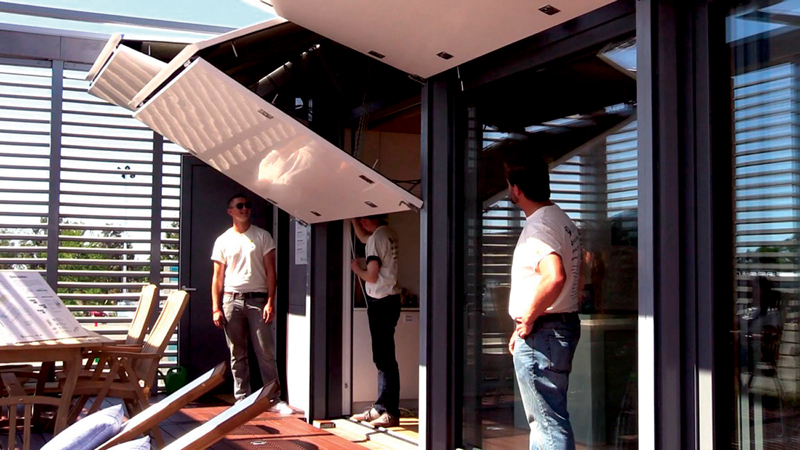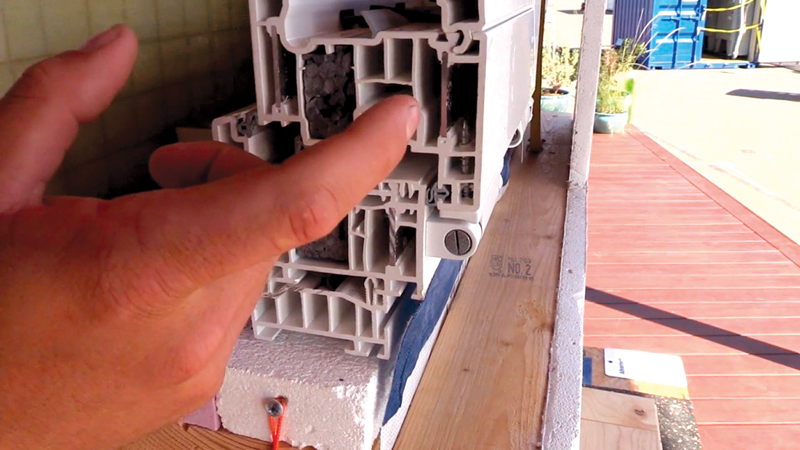This “SURE” is a Nice House
Vinyl and other plastics helped this house win the 2015 “Solar Decathlon”
Previous Article Next Article
By American Chemistry Council (ACC)
This “SURE” is a Nice House
Vinyl and other plastics helped this house win the 2015 “Solar Decathlon”
Previous Article Next Article
By American Chemistry Council (ACC)
This “SURE” is a Nice House
Vinyl and other plastics helped this house win the 2015 “Solar Decathlon”
Previous Article Next Article
By American Chemistry Council (ACC)

The SURE House’s plastic bi-fold storm shutters.

One of the SURE House’s vinyl window frames.
Note: This article continues the series of updates in Plastics Engineering from Plastics Make it Possible®, an initiative sponsored by America’s Plastics Makers® through the ACC.
What does “a house that would intellectually respond to Hurricane Sandy” look like?
As the students at Stevens Institute of Technology in Hoboken, New Jersey, see it, it starts with two concepts: sustainability and resilience. And it uses a whole lot of plastics, particularly vinyl.
“Inspired” by Hurricane Sandy, a team of Stevens students designed and created a house for the U.S. Department of Energy’s 2015 Solar Decathlon in Irvine, California. Held every two years, the “Solar Decathlon challenges collegiate teams to design, build, and operate solar-powered houses that are affordable, energy-efficient, and attractive,” says the DOE.
The Stevens team members say they conceived the house as the “coastal home of the future”—a cost-effective, net-zero energy, solar-powered home to serve as a prototype for shore communities. The house’s focus on sustainability is manifested by dramatically reduced energy consumption and its use of solar energy. It also uses marine construction methods to protect against the next 100-year storm, making it particularly resilient. Combine “SUstainable” + “REsilient” and you get the SURE House, the name for Stevens’s Solar Decathlon entry.
Tough Competition
Seventeen teams from across the nation competed in the 2015 Decathlon (including some that partnered with universities outside the USA), spending nearly two years designing and building their concept houses. The houses were scored on ten criteria related to affordability, appeal, appliances, architecture, comfort, communications, commuting, energy balance, engineering, and home life.
One of the loudest cheerleaders for the Stevens team was the Vinyl Institute (VI), a member of the plastics division of the ACC and one of the sponsors of the SURE House. “The design was about sustainability and resilience,” said Susan Wade, VP of marketing and communications for VI. “With the house being a coastal home, vinyl really played a key role. It was an opportunity to show how important vinyl is to [meeting] those design goals.”
So how did the SURE House fare when winners of this tough competition were announced in October? Let’s just say it sure did well, capturing top honors and winning in seven of the ten categories.
Hurricane-Resistant Materials & Products
Truly an example of “plastics make it possible,” the SURE House employs numerous plastic building products that contribute to energy efficiency, and it takes advantage of the inherent waterproof/resistant nature of many plastics, especially vinyl products. The Stevens team specifically set out to identify building products that would perform better than those that typically did not withstand the ravages of Hurricane Sandy. Here’s a look at some these advanced materials and products, as described by the team:
- The SURE House reduces energy use by a whopping 90% compared to an average New Jersey house, driven in part by insulation that helps minimize the exchange of air from the conditioned indoor spaces to the outdoors. As the team puts it, the house has nearly twice the level of insulation of a typical house. The house employs structural insulated panels (SIPs) as walls; SIPs typically consist of polystyrene foam insulation sandwiched between some type of wood sheathing. The roofing employs extruded PS foam insulation covered by a vinyl membrane to help increase energy efficiency and protect the house against rough weather. These plastic materials help optimize R-values and typically don’t absorb water or degrade from contact with water.
- To help withstand hurricanes, the house employs various plastic composites and structural adhesives, derived from marine construction techniques, to create barriers to repel water. For example, the exterior siding is comprised of a glass fiber and resin matrix that encapsulates a plastic foam core. This sheathing is wrapped from the underside of the house and is rated to withstand up to a FEMA 6/7 Zone, i.e., ±6 feet (2 m) of water. It contributes to energy efficiency and can minimize damage, allowing a faster recovery from flooding and storms.
- The bi-fold storm shutters installed on the SURE House serve two purposes—they shade the windows when raised, contributing to energy efficiency in warm weather, and they provide a primary defensive barrier against water and debris when closed during inclement weather. The shutters are made with a plastic composite foam core and wrapped with a glass-fiber-reinforced plastic composite. When closed, the shutters lock into place against synthetic rubber seals to resist water intrusion from a storm surge.
- To provide energy, the house employs building-integrated photovoltaics (BIPV), in this case flexible thin-film solar cells which replace typical heavy glass layers with slim layers of plastics. The lightweight panels are attached to the upper part of the bi-fold storm shutters, gathering the sun’s energy when the shutters are raised. Their light weight makes it easier for homeowners to raise and lower the shutters. The plastic panels are designed to stand up better to storms and are simpler to replace in case of damage.
- Since water-pervious floors can be subject to permanent damage when exposed to seawater, one of the primary flooring products used is water-resistant vinyl tile, which in this case is made with recycled materials. The exterior decking material also is made with vinyl to stand up to inclement weather without rotting or corroding.
- There are numerous other vinyl building products in the house that can contribute to sustainability and resiliency, such as the vinyl louvers that shade the windows, vinyl conduit protecting the electrical wiring, and vinyl pipes. Even the windows contribute to sustainability and resilience—the durable vinyl frames contain plastic foam insulation and numerous air pockets that help prevent thermal bridging (the transfer of heat through materials).
The SURE House will reside on Ocean Avenue in the heart of Seaside Park, New Jersey, serving as a permanent community outreach center and information resource designed to engender continued dialogue about sustainability and resiliency.
Congratulations to the Stevens Institute of Technology, and thanks to the Vinyl Institute for sponsoring this house and helping demonstrate once again how plastics can contribute to sustainability and resilience.
For more information on plastics, building materials, and sustainability, visit plasticsmakeitpossible.com. For information on the SURE House, visit surehouse.org. And for information on the Solar Decathlon, visit solardecathlon.gov.